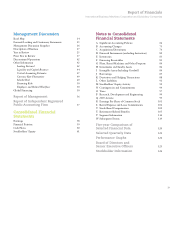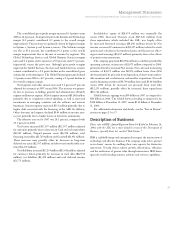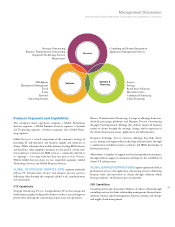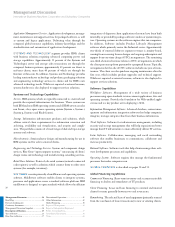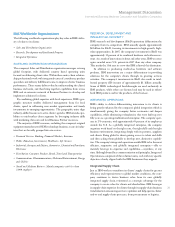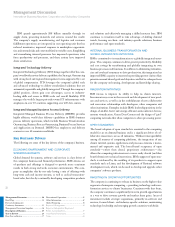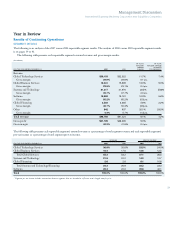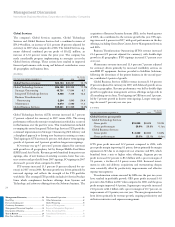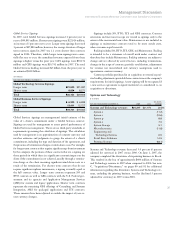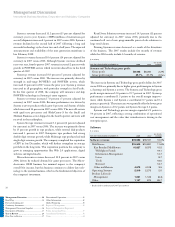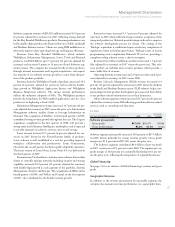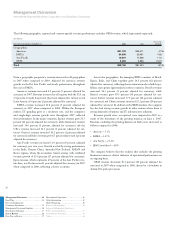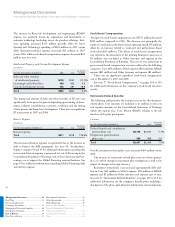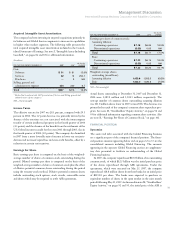IBM 2007 Annual Report Download - page 24
Download and view the complete annual report
Please find page 24 of the 2007 IBM annual report below. You can navigate through the pages in the report by either clicking on the pages listed below, or by using the keyword search tool below to find specific information within the annual report.
IBM spends approximately $38 billion annually through its
supply chain, procuring materials and services around the world.
The company’s supply, manufacturing and logistics and customer
fulfillment operations are integrated in one operating unit that has
reduced inventories, improved response to marketplace opportuni-
ties and external risks and converted fixed to variable costs. Simplifying
and streamlining internal processes has improved operations, sales
force productivity and processes, and these actions have improved
client satisfaction.
Integrated Technology Delivery
Integrated Technology Delivery (ITD) brings together all of the com-
pany’s worldwide service delivery capabilities for Strategic Outsourcing
with strong local and regional management teams supported by a set
of global competencies. ITD leverages the company’s global scale
and advanced technology to deliver standardized solutions that are
automated, repeatable and globally integrated. Through the company’s
global position, clients gain cost advantages, access to industry-
leading skills and access to IBM’s scale and overall flexibility. ITD
manages the world’s largest privately-owned IT infrastructure with
employees in over 30 countries supporting over 400 data centers.
Integrated Managed Business Process Delivery
Integrated Managed Business Process Delivery (IMBPD) provides
highly efficient, world-class delivery capabilities in IBM’s business
process delivery operations, which include Business Transformation
Outsourcing, Business Process Outsourcing, Business Process Services
and Application on Demand. IMBPD has employees and delivery
centers in over 40 countries worldwide.
Key Business Drivers
The following are some of the key drivers of the company’s business.
ECONOMIC ENVIRONMENT AND CORPORATE
SPENDING BUDGETS
Global demand for systems, software and services is a key driver of
the company’s business and financial performance. IBM’s diverse set
of products and offerings is designed to provide more consistent
results in both strong and weak economic environments. The com-
pany accomplishes this by not only having a mix of offerings with
long-term cash and income streams, as well as cyclical transaction-
based sales, but also by continually developing competitive products
and solutions and effectively managing a skilled resource base. IBM
continues to transform itself to take advantage of shifting demand
trends, focusing on client- and industry-specific solutions, business
performance and open standards.
INTERNAL BUSINESS TRANSFORMATION AND
GLOBAL INTEGRATION INITIATIVES
IBM is committed to its transformation to a globally integrated enter-
prise . The company continues to drive greater productivity, flexibility
and cost savings by transforming and globally integrating its own
business processes and functions. In addition to eliminating redundan-
cies and overhead structures to drive productivity, this integration has
improved IBM’s capacity to innovate by providing greater clarity of key
priorities around shared goals and objectives and led to a sharper focus
for the company on learning, development and knowledge sharing.
INNOVATION INITIATIVES
IBM invests to improve its ability to help its clients innovate.
Investment may occur in the research and development of new prod-
ucts and services, as well as in the establishment of new collaborative
and cocreation relationships with developers, other companies and
other institutions. Examples include IBM’s leadership positions in the
design of smaller, faster and energy-efficient semiconductor devices;
systems virtualization, Green Data Centers and the design of “grid”
computing networks that allow computers to share processing power.
OPEN STANDARDS
The broad adoption of open standards is essential to the computing
model for an on demand business and is a significant driver of col-
laborative innovation across all industries. Without interoperability
among all manner of computing platforms, the integration of any
client’s internal systems, applications and processes remains a monu-
mental and expensive task. The broad-based acceptance of open
standards — rather than closed, proprietary architectures — also
allows the computing infrastructure to more easily absorb (and thus
benefit from) new technical innovations. IBM’s support of open stan-
dards is evidenced by the enabling of its products to support open
standards such as Linux, and the development of Rational software
development tools, which can be used to develop and upgrade other
companies’ software products.
INVESTING IN GROWTH OPPORTUNITIES
The company is continuing to refocus its business on the higher value
segments of enterprise computing — providing technology and trans-
formation services to clients’ businesses. Consistent with that focus,
the company continues to significantly invest in growth opportunities
as a way to drive revenue growth and market share gains. Areas of
investment include strategic acquisitions, primarily in software and
services, focused client- and industry-specific solutions, maintaining
technology leadership and emerging growth countries worldwide.
Management Discussion
International Business Machines Corporation and Subsidiary Companies
22
Management Discussion ............................ 14
Road Map .........................................................14
Forward-Looking and
Cautionary Statements .....................................15
Management Discussion Snapshot ..................16
Description of Business ............................. 17
Year in Review ............................................ 23
Prior Year in Review ........................................37
Discontinued Operations .................................42
Other Information ............................................42
Global Financing ..............................................50
Report of Management ....................................56
Report of Independent Registered
Public Accounting Firm ...................................57
Consolidated Statements ..................................58
Notes .................................................................64



